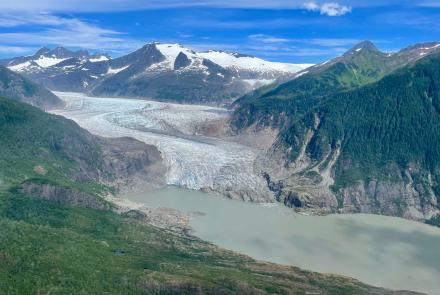Ice Fog a Product of Temperature, Topography, Dogs
Carl Benson went out to collect ice fog a few days ago.
Benson, a professor emeritus at the Geophysical Institute, took advantage of what he considers excellent weather to gather ice fog, a Fairbanks phenomenon that occurs when the temperature drops below about minus 30 degrees Fahrenheit. Along the way, Benson described what ice fog is and why it transforms Fairbanks into a fuzzy dream world pierced only by bright lights.
Ice fog is what happens when water vapor meets bitter cold air that can't hold any more water. When water vapor exits a car tailpipe when it's minus 40, for example, the water vapor temperature drops from about 250 degrees to minus 40 in less than 10 seconds. Water cooled that fast forms tiny ice particles, so small that ten of them could fit side by side on the finger-cutting edge of a piece of paper. Collectively, millions of these particles take form as ice fog, the cotton candy-like clouds that hang over our roads.
Temperature inversions, in which warm air above acts like a lid to trap cold air below, combine with hills in Fairbanks to provide a box in which ice fog forms. Inversions usually allow hilltop residents to bask in warmer temperatures than those living in low areas, but ice fog often takes away the advantage of living in the hills. Inversions usually form at the ground surface in Fairbanks, but during bouts of ice fog, inversions form at the top of the ice fog layer. The warmer air usually enjoyed by those at higher elevations forms higher in the atmosphere; those in the hills experience the same numbing temperatures as the lowlanders.
Because they spew water vapor over large areas, cars and trucks are the most visible culprits in the buildup of ice fog. But automobiles aren't the number one source of water vapor. In a research paper Benson wrote in 1965, he scouted the sources of water vapor in Fairbanks. He found the cooling water dumped from power plants into local rivers and sloughs accounted for 64 percent of the manmade water sources that could end up as ice fog. Gasoline combustion made up only 3 percent, but that 3 percent hangs where we drive.
Although not nearly the ice-fog machines that vehicles are, humans also are to blame. In his report, Benson calculated people in the Fairbanks area exhaled and sweated about 58 tons of water vapor into the air each day in 1964. Benson even averaged the water output of Fairbanks' dog population. He estimated there were about 2,000 outdoor dogs in Fairbanks in 1964. Those 2,000 resting dogs exhaled a little more than a half ton of water each day into the air, which Benson deemed "a conservative estimate because all of the dogs don't rest all of the time."
Benson figured dogs, open water, cars, stoves and other sources pumped 4,000 tons of water vapor into the air each day in 1964. He estimated the current Fairbanks water output to be perhaps more than 6,000 tons per day.
At frigid temperatures, the air rids itself of ice fog in two ways, Benson said. When ice fog mixes with warmer air at the "lid" of the inversion, some of it converts to water vapor, which is invisible. Ice fog also falls out like rain, a phenomenon Benson took advantage of when he recently went out to gather some.
To catch ice fog, Benson repeated a cold-snap ritual he has performed with other GI scientists since 1961. He placed several sheets of polyethylene-covered plywood at sites around Fairbanks. Ice fog precipitate, visible as a gray-brown layer on the snow, fell out of the air onto the plastic. Using a spatula, Benson shaved dirty frost off the rectangles of plywood. He collected the frost in a plastic water jug and sealed it. Later, he melted the residue into an unsavory broth of pollution particles and water. Besides water, ice fog contains carbon dioxide, carbon monoxide, and a slew of other chemicals wafted into the air by cars' inability to completely burn gasoline.
During a cold snap, most people in Fairbanks yearn for the magic moment when the temperature warms to about minus 30, the point at which ice fog dissolves to become water vapor. Carl Benson is perhaps the only man in town who roots for long cold snaps--they give him more time to collect samples.



